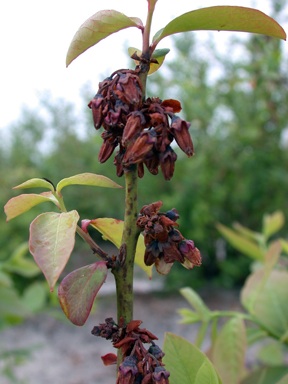
(Michigan State University)
By RACHEL IOVAN
Capital News Service
LANSING—New research from the Department of Agriculture (MDA) and Michigan State University suggests there’s a growing viral threat to blueberry plants in the state.
Two viruses, blueberry shock and scorch, had previously been seen only in the Pacific Northwest and East Coast, but were discovered for the first time in Michigan last year.
The viruses reduce or eliminate the growth of fruit, but don’t threaten human health.
According to the U.S. Department of Agriculture, Michigan’s blueberry crop is worth $124 million yearly. Van Buren, Ottawa, Allegan, Muskegon and Berrien counties are the top producers.
A summer 2010 study found scorch virus in seven fields in Allegan, Ottawa, Saginaw and Van Buren counties, but the shock virus was not detected. This year all the plants diagnosed with the disease were destroyed.
The scorch virus is named for the burnt appearance of infected blossoms, said Annemiek Schilder, an MSU associate professor of plant pathology.
Robin Rosenbaum, the Plant Industry Section manager for MDA, said the study was done because of concern over a few infected plants.
“We’re trying to stay ahead of the curve,” said Rosenbaum, “Early detection is the only way to contain viruses like these.”
Rosenbaum said MDA ramped up the study to get in front of the virus as quickly as possible.
“If you think you have an opportunity to eradicate a disease, you must have a severe response,” Rosenbaum said.
Schilder said scorch is of higher concern for Michigan blueberries because it usually kills plants, while shock-infected plants may recover over time. She said another problem is that plants can carry a virus for a few years before symptoms start, so growers who don’t see symptoms might not test their plants.
She said that scorch is also more of a concern because it was found in 2009 and 2010, and shock was found only in 2009.
Schilder said her biggest concern is that the extent of scorch isn’t as contained as she’d hoped.
“Scorch was found in more places than expected, which indicates multiple introductions of the virus,” Schilder said.
“We have preliminary indications that Michigan aphids can spread scorch,” said Schilder, who said she is currently doing research to determine if aphids can transmit the virus.
She said scorch is worrisome because infected bushes produce fewer berries and eventually die.
Mike Hansen, the regional supervisor for MDA in southeast Michigan based in St. Joseph County, said the challenge for growers is not that entire fields will die off, but that blueberry growing could become uneconomical if enough plants are affected.
In June and July, the team of researchers, asked all blueberry farms in Michigan to participate in a survey, and Hansen said only a few declined to take part.
Hansen said the survey is important because researchers can’t look at the viruses’ impact on the Pacific and East Coasts and extrapolate what could happen in Michigan because of climate differences.
Mike DeGrandchamp, a partner at DeGrandchamp Farms, which has 150 acres of blueberry fields in South Haven and participated in the survey, said no shock or scorch was found there.
“We always have virus testing in our nursery blueberry stock because if you have a problem you want to know it,” DeGrandchamp said.
Hansen said, “Right now, we’re trying to determine how we got it, how widespread it is and how we can address it.
“We have a very large blueberry industry in Michigan, so we’re best off not letting the virus run loose.”
© 2010, Capital News Service, Michigan State University School of Journalism. Not to be reproduced without permission.